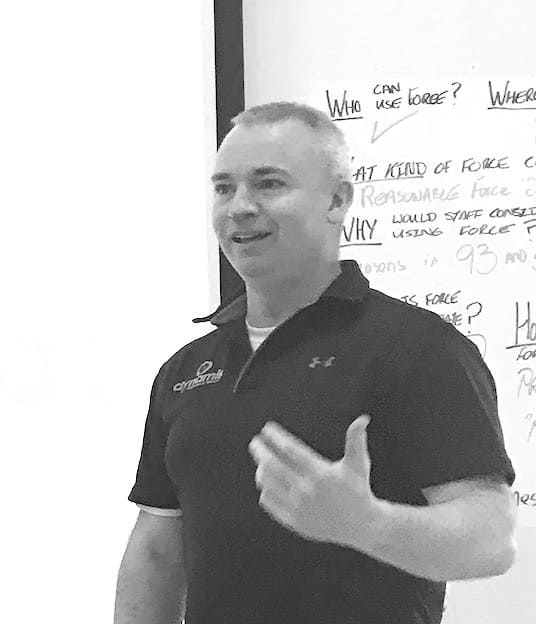
Officer Safety Train-the-Trainer
Functional tactics, taught and learned through policing scenarios.
Knowing when - and when NOT - to use force is imperative, and your team need to make decisions, protect themselves and their colleagues, and to resolve an encounter effectively.
Officer Personal Safety and Control Tactics / Arrest Skills
Course Rationale:
This course is designed to assist officers to survive a sudden, perhaps unanticipated assault during close-quarter interactions with subjects. We focus on the most probable common attacks against officers and incorporate scientific methods to prepare officers to prevail in these envcounters. The startle-reflex phenomenon and other behavioural responses to violence are core to our methodology and practice activities. The result is higher-performing officer whose tactics are resilient in the face of extreme violence.
Your officers know their high-risk calls where Arrest Self-Defence and Control Tactics will be most needed:
Within these Scenarios, your trainers need to learn how to enhance officer performance:
Modern Functional Officer Safety Training
Dynamis officer safety and personal safety, arrest and control training will enable your response teams with the knowledge, skills and judgement to be able to carry out effective interventions when police encounters involve use of force. Our trainer development programme has been designed as an evidence-based model to incorporate recent trends at College of Policing to ensure that officers are taught in a scenario-driven, task focused learning environment .
In partnership with our colleagues at world-leading conflict management company Vistelar, we are able to certify police trainers in a full Non-Escalation, De-Escalation and Crisis Management programme.
Using a behavioral personal protection method, incorporating the flinch response and instinctive protection principles, our self-protection methods are easy to learn and retain by any officer.
Turning away from decades-old methods of restraint whose deficiencies are well recognized, our high0risk control tactics programme offers officers effective methods of control which do not rely on pain or perfect conditions in order to be effective.
The scenario-driven and task-focused nature of our training programme design means that elements of mental health awareness, dealing with older and younger people and other vulnerable groups is 'baked in' to our training.

Our unique scenario-driven training approach takes your officers through an evidence-based process of increasingly complex interaction and decision-making which ensures that understanding, skills and action all improve together and your officer response is improved. SCENA forms the core of the new PPST Trainer model for College of Policing.
What we have learned about Officer Safety Training.
Henry Poincare wrote that “Science is built of facts the way a house is built of bricks: but an accumulation of facts is no more science than a pile of bricks is a house.”
Is your personal safety training package just a pile of bricks?
Let’s face it, some OST and PI programmes are a little like Frankenstein’s Monster. Over the years, bits have fallen off, bits have been added. When asked, no-one remembers why certain bits are still attached!
Or worse, there are bits hanging on that attract everyone’s attention - why is THAT there?
But perhaps the biggest issue is the absence of a Gameplan.
Imagine the instructor neatly bringing tactical ‘bricks’ to the student, one by one. Prescribed tactics for protecting from blows, peeling off grips or controlling a subject.
Let's say that, one by one, the learner is given and collects these bricks, and puts them on the pile.
Perhaps, at the end, you’ll ask your learners to “Do a Scenario”.
When you “do a scenario at the end” it is like asking someone to build a wall from the pile of bricks, with a stopwatch running and with no Ikea-like instructions.
Just see what kind of wall you get!
People more experienced with violence - having accurate mental models - will do better, but people inexperienced with violence will do less well. Those learners who show poor performance will in part do so because of poor mental-models for how violence physically happens, and their ‘gameplan’ for working through the problems it poses will likewise be poor.
Unless you somehow give them those things in the training - this is known as a 'game model'.
Recent research has suggested that Officer Safety Training in some forces may not be adequately preparing officers for the heightened risks of their work in the current climate, where assaults on police are increasing.
Since 2006, I have audited a host of personal safety and restraint training programs, some of which have dusty histories that go back over 50 years with connections to asian martial arts, and some of which are more modern methods that have come to prominence only in the last couple of decades. Every trainer I have met is convinced that there are "better tactics" and usually that their tactics are the best.
The focus on ‘tactics’ and ‘techniques’ is understandable (and it is even fun sometimes!) however as I hope to explain, the key difference may be in the teaching and NOT in the technical.
Read the rest on LinkedIn:
https://www.linkedin.com/pulse/officer-safety-training-broken-so-can-we-fix-gerard-o-dea/
I have a new insight this week which should help prospective buyers of conflict management or personal safety training to sort the wheat from the chaff.
It has to do with space.
Simply the advice is this: if the training provider isn’t asking for significant amounts of space in the training room which will be used for the training, you should become very, very interested of the quality of the training being delivered*.
Here's an algorithm I offer for your thoughts:
More Space = Better Training
Less Space = Limited Training (* see below for caveat)
Allow me to expand on this.
I had an experience recently where I was shown into all-too-typical ‘training room’ by a client who wanted me to train a group of about 10 people in a full spectrum of protective intervention skills.
The room was really well equipped. It had two desks able to seat 5 people each. It had a full-size desk for the trainer’s laptop, projector and paperwork. It had furniture for the projector and it even had its own PC and monitor. It also had seating for about 15 people around the walls.
There was a few square metres of open space. Altogether the room was completely unsuitable for breakaway or self-protection skills development. It was like so many rooms I have been shown into in the past, and shuddered at the thought of trying to train people in it.
Why?
Read the rest of this article on LinkedIn:
https://www.linkedin.com/pulse/breakaway-training-doesnt-work-space-gerard-o-dea/
Not all scenario training is training using scenarios - and what about the drills? - a conversation with Tony Torres, veteran officer safety and self-protection training expert. (interview video below)
Gerard O'Dea here, Director of Training at Dynamis - I wanted to have this conversation with Tony Torres because I believe there's some confusion in the physical intervention / officer safety training world at large about what scenario training is, when it should be done, and even what is its purpose.
I think because of the problem with definitions that we have in our sector (officer safety training, self-protection, breakaway and physical interventions), there's too little scenario training going on and I thought it would be interesting to hear Tony's perspective on whether we should be doing scenario training and if not, what is the alternative?
In our conversation we inevitably ended up talking about:
Tony Torres: "I think the main problem with scenario training - I think it's great and I think it's necessary - but the main problem that I've seen the way people interpret scenario training is that people are getting into scenario training before they have skills. Scenario training should be something that skilled people participate in to see or assess the level of skill, not a place you put people when they are participating in training in order to gain skill.
You don't gain skill from a scenario. You can only refine skill that you already have and that's where drilling comes along.
You can do a thousand or more different ways of drilling - and it can be very realistic and very safe - before you put people in a scenario.
I would venture to say that if I have four hours to train people, I'm doing three and a half hours of drilling and maybe 30 minutes of scenario and if somebody says, well you need to cut some time out of that, I'll cut 15 minutes of the scenario training because I want people that are skilled, only people that have skill, participating in scenario.
I don't want to throw anybody in a scenario where they're going to fail due to lack of skill.
So a person might fail because they slip on a banana peel - and that happens you know - I wouldn't call that failure, I just call it a sort of malfunction that can be revisited.
Gerard O'Dea: "What I'm learning from talking with yourself and Prof. Chris Cushion, is that we really haven't defined the terminology in this sector yet. For example, here we are talking about what is a scenario and what is a drill. I think what you meant when you said your people are doing lots of drills, you didn't mean that they're standing there doing a "one and done" type technique."
Tony Torres: "Oh no, no. It's repetition upon repetition. It's repetition with constant chaotic input. None of the repetitions are ever the same.
A Drill is a place to develop a skill under pressure.
Skills are very quick to learn. A tactic is very quick to learn - here's where you put your arm and this is the best way to put it.
We do five minutes of figuring out a tactic, telling our learners - "This is the best way to perform something".
Then in our system we immediately start drilling that tactic, so we put it on under different levels of pressure, sometimes under different levels of impact and sometimes we introduce the chaos and then we start introducing all three of those things at once, which naturally causes a certain amount of psychological and emotional stress, which is the most important thing about training this way, which is that people have to be exposed to impact, pressure, chaos and stress.
Your tactic has to be tested under impact, pressure, chaos and stress.
"When people can do tactics very cleanly and repetitively under input that's not predictable... (and I hate to say 'not predictable' because human violence is very predictable as far as I'm concerned), but under a level of input that's chaotic. When people can do that, then they're ready for a scenario.
The scenario is about putting them into a situation that they will find in their particular job.
The scenario needs to follow a path. Choose one of the problem work-tasks that they face in their work, for example.
So for example, you'll have someone play the character of a prisoner that's not following the instructions of the custody officer, and because we have a lot of experience in this field, we know that certain things that officer could say that might induce this prisoner into attacking him or not comply with a request, etc.
But you also know that certain ways that the officer treats the prisoner might lead the prisoner to decide, "okay, I'll do what you ask."
If you're doing a scenario where the result is always a fight, then that has become just a more advanced type of drill.
That's just drilling at an advanced level. The word scenario comes from the Greek word for "scenery", for those things that are on stage - thats what makes a scenario.
So you're watching a play and in that play, there should be options to go one way or the other. If the option is always the same, and there's always a fight in the same area, then that just became an advanced drill for fighting."
Gerard O'Dea: "The outcomes in a scenario have to be far more varied. Professor Chris Cushion talks about shaping the practices, by which we mean, the drills are very shaped - they have boundaries which constrain them. In the drill, you're supposed to be doing a certain thing, exploring a certain physical tactic in response to a certain physical attack or stimulus, but a scenario can end with just the use of words.
Tony Torres: "If you're doing Scenarios properly. There should be an option for the role player to decide and say, "okay man, everything's good. Go ahead and cuff me", or whatever it is.
A trainer should look at the training as a continuum.
That's the problem with most training programmes and their scenario training. They will have, "technique" training. They don't do drills and isolation exercises with chaos, impact, pressure and stress but then they'll run a scenario. So here's the learner's training on one side of the experience and here's them being dropped into a scenario on the other side of the experience...and there's nothing in between.
Then that cognitive dissonance kicks in for the learner and they think: "I have no idea what to do... I have no idea what to do."
They might not be verbalizing that, but it's certainly a thought-feeling spinning in the back of their head, because there was nothing in-between during their practices to link the technical- or tactical- practice to the context of a seriously stressful physical confrontation.
Our training is set up so that it's a continuum.
We start with absolutely zero pressure, zero impact, just a little bit of psychological stress, and we progress by layering pressure, impact, chaos and stress over and over in many repetitions, so by the time we have progressed to the advanced drills, they appear to progressively look more and more like a real physically violent encounter.
As our learners go through that continuum, eventually at the very end should be, quite naturally, scenario training!"
--------------------------------------------------------------------------------------
Tony Torres and Gerard O'Dea have collaborated since 2006 on training in personal safety, self-protection and control tactics for varied occupational use-of-force contexts.
Periodically there is Trainer-level training in the UK for progressive trainers wishing to add to their repertoire and deepen their skill in teaching self-protection.
https://www.linkedin.com/pulse/officer-safety-training-we-need-sort-drills-from-scenarios-o-dea/
We promote a task-based approach to training design and delivery, incorporating an evidence-based methodology we have developed in cooperation with Professor Chris Cushion at Loughborough University School of health and sports science.
In event-based training, events are embedded into training to achieve desired training objectives and provide opportunity for the trainee to apply skills in an environment representative of real world operational conditions.
Training Fidelity
Thought-leaders in the field of confrontation training recognise that the best way to design a training programme is to look at the types of scenarios in which our trainees may be faced with a performance challenge, and then place those scenarios at the very center of our thinking.
In this way, we ensure that the programme of training is relevant, effective and contextualised to provide the greatest benefit to the trainees when they need to put the skills they are being trained in, to use.
“training fidelity refers to the extent to which the characteristics of the training environment are similar to the characteristics of the criterion setting” PERFORMANCE UNDER STRESS (Hancock and Szalma 2008)
Ideally, the more fidelity the scenario exercise has with reality, then the better the result of our training, however it is possible to overwhelm the trainees with too high a level of fidelity and so cautious planning about the thresholds to which the training should cross / not cross are set in advance.
Our use of Impact Reduction Training Armour allows us to drastically improve and increase our level of training fidelity with role-players who can move naturally, broadcast congruous body-language and cues and then who can be impacted and controlled at close to full speed and full force by our trainees. This level of fidelity could not be possible without the use of such robust and specially-designed gear.
Scenario-Driven Training Model
We understand that there is significant difference in what it takes to perform a task in a benign environment and what adequate performance requires in a hazardous or high-demand environment (such as the use of physical intervention or protection skills during a confrontation).
The difference in the effectiveness of training is how the contextual environment impacts on performance: “consideration of the contextual factors that impinge on task performance is critical to maintaining effective performance in real-world settings” PERFORMANCE UNDER STRESS (Hancock and Szalma 2008)
The distinction between effective training and less-effective training, then, is the extent to which the training deals with and incorpoates these contextual factors which are (quite literally) part of the furniture in real-world scenarios!
We argue that the primary goal of any training programme is skill acquisition and retention, however high-stress environments include specific task conditions and require responses which differ from those found in the sterile classroom environment.
Our training is event-based – the event itself becomes the curriculum.
An event is defined as: “a specific task procedure with corresponding performance conditions. Events may be discrete and singular or they may be multiple events connected into a series representing a longer scenario. Events are defined to represent real world events and contextual demands.”
Your team learn in a scenario-driven 'mesh'
Communication Skills
Your teams will model and practice appropriate verbal skills for preventing and de-escalating conflict.
Behaviour Awareness
Your team will develop their awareness of people's behaviour and the ways in which situations can trigger distress, anger or emotional disturbance.
Teamwork during incidents
Your team will have to work together to solve problems, learning along the way how to think and to communicate as a team
Self-Protection
Your team will be challenged to develop personal safety habits and perform robust, appropriate self-protection tactics in many different scenarios
Legal Rules for Use of Force
Your team will reflect on the legal basis for their actions, based on national-level guidance - also assisting in effective reporting.
Restraint Reduction Principles / Community Engagement
Your team will be challenged to embody restraint-reduction principles in each scenario they work through
Risk
Awareness
Every restraint carries risk, so your team must learn how to navigate options and reduce the risk of adverse outcomes through serious injury or death.
Arrest and Control Skills
Your team will develop flexible skills to perform safe holding, control or restraint appropriately to the level of risk
With over 15 years of experience working with clients, we are confident that we can gain an understanding of your issues, resources, timeframes and budget quickly and soon propose a training plan which fits your needs.
Our Process for Working with You
HI! I'M GERARD O'DEA
Director Of Training At Dynamis
Hi And Thanks For Visiting Our Webpage Today.
In Over 15 Years Of Working With Frontline Staff Who Face Difficult, Distressed And Dangerous Behaviour, I Have Seen Time And Again How Prepared Staff Can Perform Well And Respond To Challenging Circumstances.
From Teachers To Nurses, Teaching And Care Assistants To Security Officers In Our Hospitals And Social Workers In The Community, If You Deal With People Every Day, Managing Conflict Becomes A Necessity.
I Became Involved In This Work Because I Saw The Power Of Training And Preparation In Helping People To Stay Safe At Work And To Be More Successful In Working With Their Colleagues To Create Better Outcomes.
I And My Team Of Professional Trainers Now Teach In Over 600 Training Engagements Every Year Around The UK And Internationally For A Wide Variety Of Public-Facing Organizations Just Like Yours.
We Have Sought Out The Best Conflict Management Training Content And The Best Learning Methods In The World And Bring Them Together For You And Your Team.


our w's
When: Our trainer courses are usually no less than 5 days for Officer Safety. If your trainers need to learn a teaching methodology for scenario-driven programmes, then we have a 5-week track which incorporates all of the appropriate tactics, legal input, post-incident procedures, coaching behaviours, session design, practice design and learner assessment requirements for your team to level-up.
Who: Groups of up to 12 trainers are led by the Dynamis team (larger groups by request). Dynamis is an ICM Accredited Quality Award centre, assuring clients of our robust processes for the design, development, delivery and support of our training programmes.
Where: Training is normally held at your venue. Venues can be sourced where needed.
How: Our Master Trainers deliver this course using a mix of lecture/presentation, Q&A, physical practice and scenario rehearsal.
Why: ✓ Matched to your needs ✓ Led by Professional Trainers ✓ Legally Audited ✓ Fully Risk-Assessed ✓ Values Dignity and Respect ✓Safeguards Client rights ✓ Offers Staff Practical Options ✓ Compliant with Government Regulations ✓ Value for Your Investment
Our Partners and Accreditation

Award Centre with THE INSTITUTE OF
CONFLICT MANAGEMENT
Dynamis is a Quality Award Centre with the ICM, a recognised accrediting body in the U.K. for workplace training in the prevention and management of workplace violence.

EUROPEAN PARTNER FOR
Dynamis is the premier European Partner for Vistelar, a global consulting organisation covering training across the entire spectrum of human conflict.

5-Star endorsement by the sector's leading expert panel
"This is our highest level of award and indicates that we could not identify any areas of your operation that require amendment or improvement. "
Frequently Asked Questions
Usually the training venue will be our client's responsibility and full details of this are made clear around the time of booking so that you know what we are going to need to give your people the best possible experience of training with our team.
We have often helped our clients to source appropriate training venues, where that assistance was requested!
Due to the nature of our training approach, we often require a good-sized training room which has the capacity for your team to move around in and in which we can set up scenarios which are as close as we can get them to real-world applications of the material we teach your people.
Our training costs are often calculated on a per-day basis and directly related to the Needs Analysis which we carry out with you.
We are constantly working to make sure that the investment level is reasonable and competitive.
We generally ask for an investment which takes into account the type of content we are going to work on with your staff, the numbers of staff involved, the risk level of the encounters they engage in and the number of days of training which will be required to get your people up to the proper standard.
We are VAT registered and all pricing sent to you is 'plus VAT at the prevailing rate'.
We also charge travel expenses which you should discuss with our training advisor so that these are as clear as possible as you book in your training course.
Our training advisor is waiting to have a call with you to discuss your timelines and preferred schedule. We generally book training 4-6 weeks out from today, however we always have been able to respond to clients who need training 'as soon as possible' when urgent needs pop up. The sooner we talk with you, the sooner we can get the training in place!
There are numerous formats which we use to deliver training with your team, whether it be a large group or a smaller team. We know that the best group sizes for learning depend on the complexity of the material to be covered, the amount of time we have with your people and also the constraints you may be working with in your budget and resources. Most of our clients put 12-16 people in our less-physically demanding training courses, and often fewer people than this into our more demanding courses. Let's talk about the best solution for your needs....
Dynamis has attained the respected Quality Award Centre status (QAC #2201) with the Institute for Conflict Management (ICM), demonstrating our commitment to quality assurance and strict adherence to the most recent guidance on the management and prevention of workplace conflict. All our trainers are fully qualified and attend CPD development on a regular basis in accordance with ICM requirements.
Our goal is that you see a tremendous improvement in your team's ability to prevent and manage difficult encounters with the people in your service, so we focus on making sure that each training session with your people feels directly connected to their everyday work and is compliant with the relevant guidance which governs it.
100%
You are fully protected by our 100% Satisfaction-Guarantee. If you are not fully satisfied by the training we deliver for your team, just let us know and we'll send you a prompt refund.
Gerard O'Dea